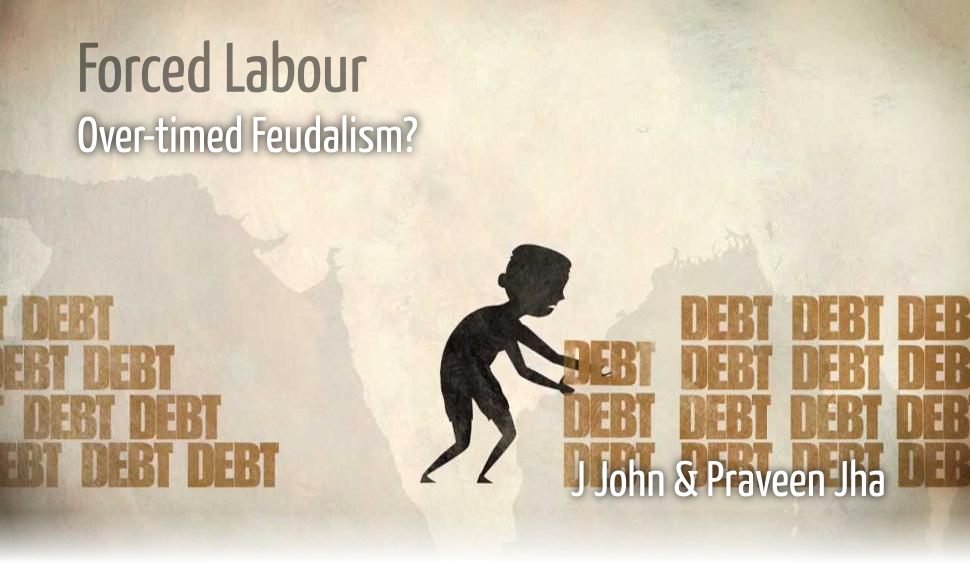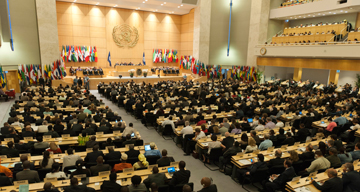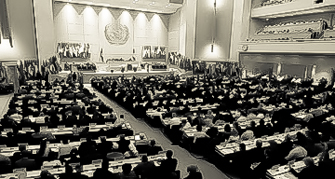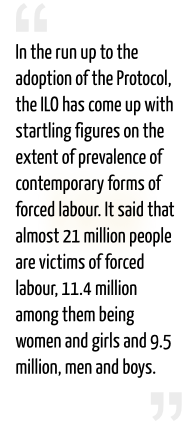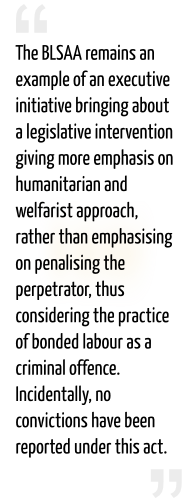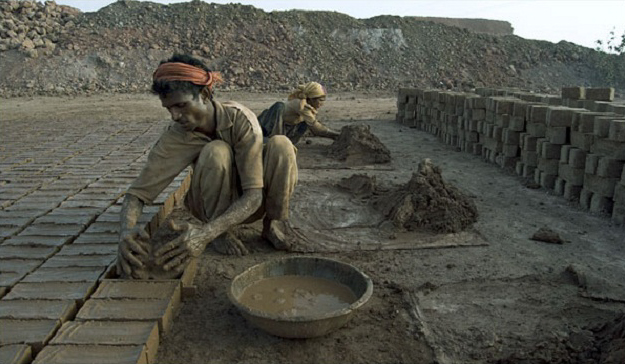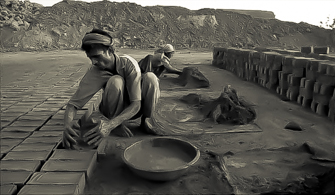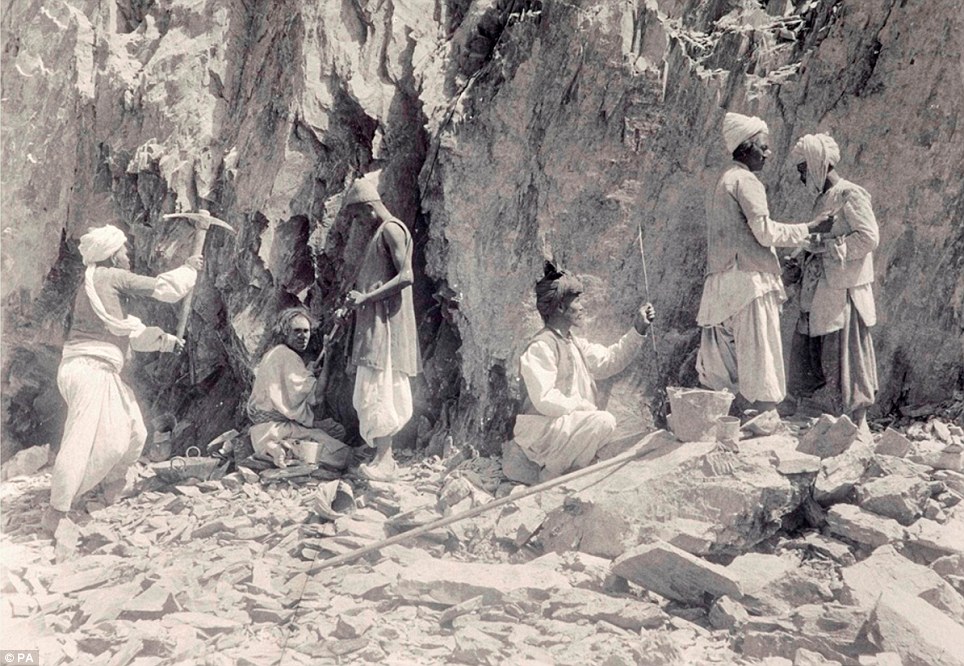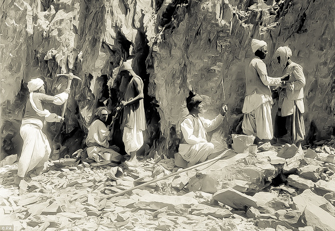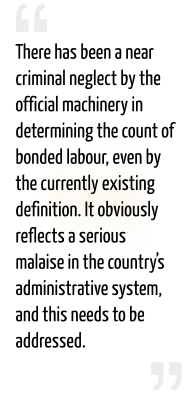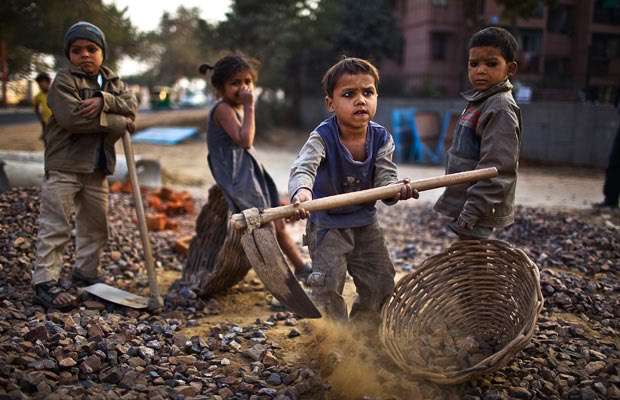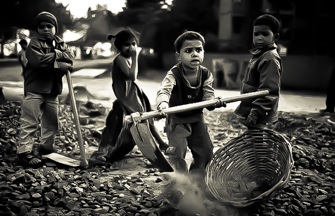Video cover realised on the basis of Walk Free’s wonderful video
23 June 2014While the gols in Brazil have been giving us our nighttime thrills, the days that just passed also presented us with some uninspiring developments. The annual International Labour Conference attempted to reach a consensus over the ratification of a protocol reinforcing the implementation of legal measures against forced labour. But this significant meeting saw some conspicuous oppositions: the new military regime of Thailand voted against the treaty, while most of the Gulf countries abstained. A minority group, which India seemed quite tempted to join. Are we witnessing a historical turn, where emerging powers dare defy international bodies on what could have been thought some time ago as irrefutable improvements on the working conditions of human beings? Or, are we indeed moving towards a healthy acceptance of alternative views on socio-economic practices within specific cultures, rather than homogenising the notion of work by negating all local dynamics of labour? Then, is there a way of doing it with care and sensitivity without violating human rights or falling into hegemonic traps? In this week’s Inter-actions, labour rights expert J John reflects on the initial resistance of the Indian representatives towards the ratification of the universal protocol. Academic Praveen Jha puts the event into relief, returning to the various historical stages of the regulation on forced labour in India, towards its distressing state today. |
Hold the cursor on the illustrations to display animations and descriptions.
A Reluctant India?J John |
India’s Bonded and DispensablePraveen Jha |
||||||||
Requested file could not be found (error code 404). Verify the file URL specified in the shortcode. |
Listen |
Listen |
Requested file could not be found (error code 404). Verify the file URL specified in the shortcode. |
||||||
|
The Government of India’s position seems to have gone through a change, between the beginning of the 103rd Session of the International Labour Conference (ILC) in Geneva in late May, and its conclusion on Wednesday 11 June 2014. The meeting was marked by the adoption of a protocol legally binding governments to the ILO Convention 129 on Forced Labour. The ILC was perhaps the first multi-lateral forum attended by representatives of the newly elected government, since the notice of the constitution of the 16th Lok Sabha and Narendra Modi’s assumption of the post of India’s 15th Prime Minister. The Indian delegation went to the ILC with an administrative brief against a legally binding protocol. As per the reports, India “expressed her Government’s wish to have an instrument in the form of a Recommendation which would provide practical guidance in the implementation of Convention No. 29.” The representative stressed that national governments should be able to devise their own strategies to tackle forced labour, based on national conditions and practice. In this view, having a binding instrument not allowing for flexibility would be counter-productive. The International Labour Organization The Government of India, a founder member of the ILO and a signatory of the ILO Conventions (29 & 105) on forced labour, saved face and avoided a humiliating situation when it finally supported the adoption of the protocol on 11 June 2014. It would be optimistic to assume that this change in position had happened based on a directive from the new National Democratic Alliance (NDA) government. What responsibility does it leave on the government? The Protocol retained and affirmed the definition of forced labour as set out in Convention No. 29. As ILO had put it, “the new Protocol brings the existing ILO Convention 29 on Forced Labour, adopted in 1930, into the modern era to address practices such as human trafficking.” The ILO Convention 29 defined forced labour, a form of practice of slavery, as “all work and service which is exacted from any person under the menace of any penalty and for which the said person did not offer himself voluntarily.” This definition formed a supplement to the 1926 UN Convention on Slavery, defining slavery as “the status or condition of a person over whom any or all of the powers attaching to the right of ownership are exercised.” ILO looked at forced labour as human rights violations at work and addressed situations of labour exploitation after the abolition of slavery.
While both Conventions addressed situations of exploitation of human labour for extraction of profit during and after colonialism, neither of these could effectively stop its ever-evolving manifestations by the states, private individuals and corporations. In the run up to the adoption of the Protocol, the ILO has come up with startling figures on the extent of prevalence of contemporary forms of forced labour. It said that almost 21 million people are victims of forced labour, 11.4 million among them being women and girls and 9.5 million, men and boys. It further said that about 19 million victims (90 per cent) are exploited for profit, estimated over US$150 billion, by private individuals or enterprises, and over 2 million by the state or rebel groups in sectors like domestic work, agriculture, construction, manufacturing and entertainment. Of those exploited by individuals or enterprises, 4.5 million are victims of forced sexual exploitation. The report says that 44 per cent of these came from migration or trafficking for labour. The retention of the phrase, “women and men, girls and boys” in the Protocol, despite an aborted attempt by India to bring in an amendment against it, is significant: it recognises the distinctive contemporary forms of exploitative practices. The recognition and emphasis on trafficking as forced labour complement and strengthen the UN Protocol 2000, generally known as Palermo Protocol, which aimed at preventing, suppressing and punishing the trafficking of persons, and in particular women and children. The definitional article (Article 3) of Palermo Protocol specified that: “Trafficking in persons shall mean the recruitment, transportation, transfer, harbouring or receipt of persons, by means of threat or use of force or other forms of coercion, of abduction, of fraud, of deception, of the abuse of power or of a position of vulnerability or of the giving or receiving of payments or benefits to achieve the consent of a person having control over another person, for the purpose of exploitation. Exploitation shall include, at a minimum, the exploitation of the prostitution of others or other forms of sexual exploitation, forced labour or services, slavery or practices similar to slavery, servitude or the removal of organs.” That a tripartite body, represented by governments, employers and workers with equal power, could debate and elaborate on such a policy is momentous. However, whether the Protocol and Recommendations will translate into a “firm commitment among governments, employer and worker organisations to eliminate contemporary forms of slavery” as Guy Ryder, ILO Director-General put it, is not granted. It will depend exclusively on the resolve of the state parties to formulate relevant national laws, on their commitment to implement the Protocol and on the vigilance of human rights defenders and workers organisations in stepping up struggle against forced labour. Article 23 of the Indian Constitution, which stipulates the prohibition of traffic in human beings, begar and forced labour as an enforceable right, is part of the lofty objective of social and economic transformation that can happen through Constitutional means. It is also worth noting that the Indian Constitution, which came into force in January 1950, chose to use the expression ‘forced labour’ rather than ‘slavery’, when articulating the fundamental ‘right against exploitation’ of Indian citizens. The Bonded Labour System Abolition Act, 1976 (BLSAA or BLA), established twenty-six years after the adoption of the Constitution, flowed directly from Article 23 of the Indian Constitution, even though its roots were in the international definitions of slavery and forced labour of the day. The BLSAA drew also from the ILO Forced Labour Convention, 1930 and the UN Supplementary Convention on the Abolition of Slavery, Slave Trade, and Institutions and Practices Similar to Slavery, 1956.
Unfortunately, the BLSAA remains an example of an executive initiative bringing about a legislative intervention giving more emphasis on humanitarian and welfarist approach, rather than emphasising on penalising the perpetrator, thus considering the practice of bonded labour as a criminal offence. Incidentally, no convictions have been reported under this act. Moreover, the act did not provide for addressing the trafficking of individuals for bonded labourers and similar practices in other such exploitative situations. The brick kiln industry employs crores of vulnerable workers There are no official estimates on bonded labour in India, though unofficially, it is estimated that millions of workers are forced to work against an advance, under situations of severe restrictions on freedom of mobility. Consider the case of brick kilns in India, where about 90 per cent are migrants who work against an advance they receive before joining work. One brick kiln, with a capacity of producing 30 to 40 lakh units per season, usually employs around 250 workers. Estimates about the number of functioning brick kilns in India vary from 50,000 to 100,000. This means that employment in brick kilns can vary from 12,500,000 (1.25 crores) to 25,000,000 (2.5 crores) in a season, most of them migrating in extremely vulnerable conditions. The regulatory ineffectiveness of Indian law against bonded and forced labour is also due to the extremely meek provisions of the Inter-State Migrant Workmen (Regulation of employment and Conditions of Service) Act, 1978, which too did not have provisions to address trafficking. The Child Labour (Prohibition and Regulation) Act, 1986, the most applied act, also counts serious deficiencies like its restrictive applicability to only those employments considered hazardous, its contested definition of ‘child’ and its absence of provisions to address the trafficking of children. According to the latest World Bank reports, India is the highest foreign exchange remittances recipient in the world, worth $70 billion in 2013 from its migratory workforce. According to the data of the Ministry of Overseas Indian Affairs (MOIA), there are about fifty lakh overseas Indian workers all over the world. More than 90% of them are in the Gulf and Southeast Asian countries. Most of these workers are unskilled and semi-skilled, and their migration is temporary, till their return to India, after expiry of their contractual employment. It has been proved that the Emigration Act, 1983 has not been effective in addressing increasing instances of trafficking and forced labour of Indians migrating abroad. Of significance here are the sections 370 and 370(A) of Criminal Law Amendment Act, 2013 (CLA), brought in by the Parliament in the wake of public outrage, and the demands for legal reforms against rape. The Indian Parliament included within the several new offences to deal with violence against women, including, significantly, trafficking. Here again, though it falls within the definition of trafficking in the Palermo Protocol, the Act omits reference to forced labour, restricting its applicability against all contemporary forms of forced labour. If the ILO Protocol to Forced Labour Convention is to be of meaning to Indian citizens, the government of India needs to be proactive and it must start streamlining its legal and regulatory instruments. Human rights defenders and workers’ organisations have a bigger challenge before them – to defend, protect and advocate in hard times. |
“Bonded labourers are non-beings, exiles of civilisation, living a life worse than that of animals, for the animals are at least free to roam about as they like… This system, under which one person can be bonded to provide labour for another for years and years until an alleged debt is supposed to be wiped out, which never seems to happen during the lifetime of the bonded labourer, is totally incompatible with the new egalitarian socio-economic order which we have promised to build.” Justice PN Bhagwati, Indian Supreme Court judge (1983) A bonded labourer is one who is forced in a work-contract against an advance, and who cannot get out of it till the debt (advance plus interest on it) is cleared. The cornerstone of the Bonded Labour System Abolition Act of 1976 (BLA) was a foundational reasoning on the question of forced labour itself. The BLA defined ‘bonded labour’ as embedded in what it called the ‘bonded labour system’ characterised by un-free labour based on debt-advances by the employer/creditor. The contract between the two parties could be either oral or written. In such contracts, the debtor or a member of his/her family did not have the right to any regular wage flow, as the debt was to be adjusted, till it was completely cleared, against labour of the debtor and/or members of her/his family, including descendants. The way the ‘bonded labour system’ had evolved in India was such that, typically, labourers under such a system were at the beck and call of the masters, with rare instances of well-defined tasks – they were supposed to render any service that the master or his family commanded. And there had been a concentration of certain castes and communities among bonded labourers. The first legislations on forced labour were signed At the time of India’s Independence from the British rule, the bonded labour system was a significant feature across the country. The Constitution of India had taken note of it through its Article 23, which expressly bans any forced labour, or begar, and trafficking of human beings. Unfortunately, it took the country’s lawmakers more than a quarter century after the adoption of the Constitution to put an Act in place – the BLA. Given the scale of the problem under the traditional bonded labour system, the Act was indeed one of Indian Parliament’s historic legislations. Based on very careful considerations by the country’s legal and administrative luminaries, the BLA spelt out clear mechanisms for identification and rehabilitation of bonded labourers, while making the employment of such labour itself a criminal offence. But, even though the Act was extraordinary, it remained organically connected with the notion of bondage/un-freedom within the ‘traditional bonded labour system’, a point mentioned right at its outset. Furthermore, the implementation of the Act would be extremely poor, as has been repeatedly pointed out by the country’s apex courts (in particular the Supreme Court) and the National Human Rights Commission. India’s administrative machinery, as also its larger socio-political fabric, seems to have a high degree of tolerance for un-free labour, if not an outright culture of denial for this serious and pervasive problem.
The BLA, through a subsequent amendment, came to specify that workers under the Inter-State Migration Workmen Act 1970, as well as the Contract Labour Act 1970, would come under its coverage, should the labour contracts be similar to terms defined by the BLA. Sure enough, this amendment broadened the scope of the BLA, yet, arguably, it still remains seriously inadequate, for a variety of complex reasons, in its conception of what constitutes bonded/un-free labour in contemporary India. The main point is that the whole range of new forms of bondage, which many researchers describe as ‘neo-bondage’, have emerged over the years, while old and traditional forms have not quite disappeared, even though they are less prevalent. The material reasons for the stubborn survival and co-existence of bondage and neo-bondage are quite obvious, given problems of lack of land and other resources (tangible and intangible), and lack of (decent) employment opportunities. But it is also that the State has prolonged its perpetual denial, or, at best, its lip service, when it comes to the issues of substantive freedom and the well being of the masses in general. Extensive work timings and irregular shifts are part As is well known, more than 90 percent of the country’s labour force is engaged in the so-called informal sector, where un-free labour is pervasive in myriad forms. Research on India’s labour market is replete with stories of excessive long hours of work, often without breaks between shifts, irregular shifts, paid or unpaid forced overtime, payments below legally mandated threshold limits… all of which marking the signs of un-freedom. There are many segments of the country’s work force, much of it invisible, who are exploited and abused on a routine basis. They often work under inhuman conditions, not very different from the sorry state of affairs highlighted in Justice Bhagwati’s quotation from thirty years ago. To give just one example, field reports suggest that the segment of domestic workers in India – nannies, cooks, maids and a variety of care workers – are frequent victims of economic, social and at times sexual exploitation. But unfortunately, very little of it seems to have been heard at all in official records and discourses. Apart from domestic work, a whole range of economic sites, such as construction, brick-kilns, stone-quarries, carpet-weaving, etc. are full of labour practices and relations characterised extensively by near-total surrender/loss of freedom as regards the workers. Almost all such workers are employed on casual and insecure contracts, which can be changed at will by the employers. We may also note that most of these economic activities have substantial incidence on child labour, which is supposed to be illegal by the laws of the land.
Thus, the challenges confronting the problem of forced labour in India are manifold. First of all, there has to be a genuine recognition of the pervasive and rampant nature of the issue in public policy, through a considerable broadening of the definition of the problem itself. Second, there has been a near criminal neglect by the official machinery in determining the count of bonded labour, even by the currently existing definition. It obviously reflects a serious malaise in the country’s administrative system, and this needs to be addressed. Third, India has been a votary, through several international fora and conventions, of what the 1948 Universal Declaration of Human Rights (UDHR) strongly affirmed as the principles that “no one shall be in slavery or servitude” and that “free choice of employment” should be guaranteed to all workers. Going by its own Constitution and its commitment to international conventions, it is high time for India’s public policy to address the problem of forced labour with due seriousness, in open and credible partnership with the International Labor Organization. One obvious issue in such a partnership is the reaching of a shared understanding as regards the nature of un-free labour, in a human rights framework, which would be amenable to legal and administrative monitoring. Clearly, this will not cover every infringement of labour rights, or provide protection from every conceivable exploitation, associated with work contracts. But, indeed, India’s BLA is unduly narrow and specific, connecting forced labour to debt-advances. There is thus an urgent need, in consultation with organisations such as the ILO, while also looking at the relevant global practices, to move forward, towards broadening the scope of the notions and definitions of forced labour. India’s persisting inequalities point towards foundational political From a policy perspective, however, the legal and administrative initiatives possibly come second to addressing the root causes underlying the stubborn persistence of un-free labour. This is precisely where there are huge deficits in India’s story of economic transformation since Independence. Today, while the country can boast of the second highest number of billionaires in the world, it also has to contend with the fact that desperate poverty, substantial malnutrition and hunger, as well as wide-scale unemployment are serious problems affecting substantial sections of the masses. Extremely inadequate land reforms and serious neglect of the mobility-opportunity for the bottom half of the country is at the core of the root causes that permit such a state of deprivations to continue, often becoming itself a fertile ground for the persistence of forced labour. Unless the root causes are addressed, relying only on legal options will simply make the existence of forced labour an ‘underground one’ (as indeed has been the case for much of the post-Independence period). One suspects that in the contemporary era, marked by the dominance of the neo-liberal economic policy framework, prospects of addressing the root causes are relatively dim. And thus, the struggles have to start from the contestation of the dominant policy regime. |
||||||||
|
J John is Executive Director of the Centre for Education and Communication (CEC), based in New Delhi since 1994. His areas of specialisation are unorganised labour and small producers. At CEC, J John initiated and guided several action research and policy advocacy programmes on a variety of fields: child labour, corporate social responsibility, universal social security, rights of migrant workers, contemporary forms of slavery, and others. J John is among the founders of the English bimonthly Labour File and his writings appeared in various national and international journals.
|
Praveen Jha is Professor of Economics at the Centre for Economic Studies and Planning (CESP), and concurrent faculty as well as Chairperson of the Centre for Informal Sector and Labour Studies (CISLS), School of Social Sciences, Jawaharlal Nehru University. He has been a Visiting Fellow to various institutions and universities, both in India and abroad, and is currently Honorary Visiting Professor to Rhodes University, South Africa, as well as the African Institute of Agrarian Studies, Harare, Zimbabwe. He is one of the Editors of the journal, Agrarian South: Journal of Political Economy.
|
||||||||
Disclaimers: The opinions expressed by the writers are their own. They do not represent their institutions’ view.
LILA Inter-actions will not be responsible for the views presented.
The images and the videos used are only intended to provide multiple perspectives on the fields under discussion.
Images courtesy: Walk Free | International Labor Organization | Akwesell | Daily Mail | List Top Tens | Yesnomaybeso
Voices courtesy: Satchin Joseph Koshy & Samuel Buchoul
Share this debate… |
… follow LILA… |
||||
